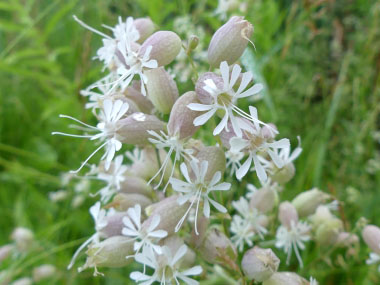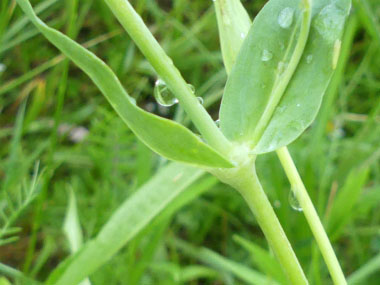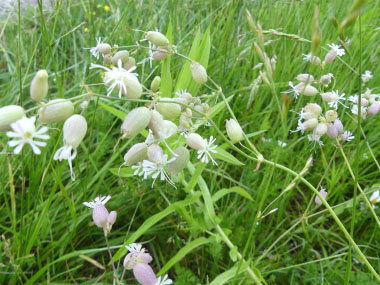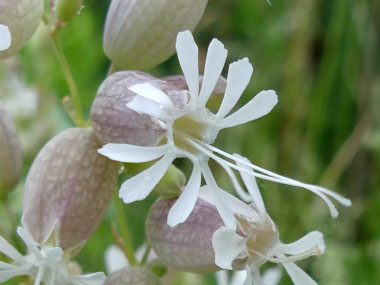






To support our efforts please browse our store (books with health benefits, etc.).
Bladder campion is a perennial plant species of the genus Silene of the pink family (Caryophyllaceae). The plant is native to Europe and western Asia and naturalized throughout the U.S., Canada, southern Australia and in New Zealand. This is an unusual plant with white, slightly drooping flowers above a purplish veined bladder. It is a nectar plant for butterflies. Silene, the genus name, is a reference to the Greek woodland god Silenus the foster father of Bacchus, who was often depicted covered in a sticky foam and whose name in turn comes from the Greek word for saliva. The specific epithet vulgaris means common.
Distinguishing Features
Up to a metre in height, bladder campion is a much-branching perennial with drooping white flowers, but it is the large inflated calyx that gives this plant its common name and makes it so instantly recognisable.
Flowers
Branching clusters of stalked flowers occur at the tips of branching stems and arising from upper leaf axils. Flowers are small, about 2cm (¾”) across and about 2.5cm (1”) long, with 5 spreading white petals each deeply divided into 2 rounded lobes. Long white stamens with dark tips and 3 pale styles extend out of the throat. The calyx is light green to pinkish, smooth with distinct venation, has 5 small triangular lobes at the tip, and is typically resembles an inflated (oval to almost round) balloon. This plant blooms anytime from June to August.
 Fields
of Nutrition has medicinal benefits and vitamin/mineral content of Bladder Campion.
Fields
of Nutrition has medicinal benefits and vitamin/mineral content of Bladder Campion.
Leaves
Leaves are 2cm (¾”) to 7cm (3”) long, and are up to 3cm (1¼”) wide. They are narrowly lance to oblong or they may be widest above the middle. Margins are smooth, leaves are hairless to sparsely hairy, pointed at the tip, rounded at the base. They are stalkless and nearly clasping. They are light green and smooth with a waxy bloom.
Height
This plant can grow to 1 metre (3') tall. Bladder campion usually branches and can look gangly.
Habitat
Bladder campions grow in many areas in which the soil is typically dry. It can be found along roadsides, edges of fields, and even in waste places.
Edible Parts
Young shoots, leaves (preferably before the pplant flowers) and flowers. Small quantities only are advised. This species might have been consumed since ancient times, but the earliest references are from the seventeenth century in Spain and the eighteenth century in France.
Other Name
Cowbell.
Similar Plants
White Campion.
Winter Survival Food Handbook

PDF Plant Magazines
Types of Wild Food
Geographic Zones Seasons
Disclaimer
EdibleWildFood.com is informational in nature. While we strive to be 100% accurate, it is solely up to the reader to ensure proper plant identification. Some wild plants are poisonous or can have serious adverse health effects.
We are not health professionals, medical doctors, nor are we nutritionists. It is up to the reader to verify nutritional information and health benefits with qualified professionals for all edible plants listed in this web site. Please click here for more information.
Why Edible Wild Food?
- Food costs are rising
- Free, wild food is readily abundant
- Wild food adds nutrition to your diet
- Wild food can help treat various medical conditions





